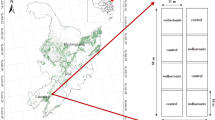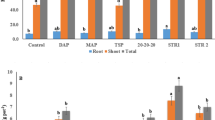Abstract
Nickel (Ni) phytoextraction using hyperaccumulator plant species to accumulate Ni from mineralized and contaminated soils rich in Ni is undergoing commercial development. Serpentinite derived soils have a very low ratio of Ca/Mg among soils due the nature of the parent rock. In crop plants, soil Ca reduces Ni uptake and phytotoxicity, so it is possible that the low Ca of serpentine soils could limit hyperaccumulator plant tolerance of serpentine soils used for commercial phytomining. In this study, we investigated the effects of varied Ca concentration in the presence of high Mg characteristic of serpentine soils on Ni uptake and tolerance by serpentine-endemic species Alyssum murale Waldst. et Kit. and A. pintodasilvae T.R. Dudley in comparison with cabbage (Brassica oleracea L. var. capita) in a nutrient solution study. The levels of Ca and Mg used were based on serpentine and normal soils, and Ni was based on achieving over 1% Ni in Alyssum shoots in preliminary tests. Varied solution concentrations of Ni (31.6–1,000 μM for Alyssum, 1.0–10 μM for cabbage) and Ca (0.128–5 mM) were used in a factorial experimental design; 2 mM Mg was used to mimic serpentine soils. Alyssum spp. showed much greater tolerance to high Ni, high Mg, and low Ca solution concentrations than cabbage. For Alyssum spp., Ni induced phytotoxicity was only apparent at 1,000 μM Ni with relatively low and high Ca/Mg quotient. In the 1,000 μM Ni treatment, shoot Ni concentrations ranged from 8.18 to 22.8 g kg−1 for A. murale and 7.60 to 16.0 g kg−1 for A. pintodasilvae. Normal solution Ca concentrations (0.8–2 mM) gave the best yield across all Ni treatments for the Alyssum species tested. It was clear that solution Ca levels affected shoot Ni concentration, shoot yield and Ni translocation from root to shoot, but the relation was non-linear, increasing with increasing Ca up to 2 mM Ca, then declining at the highest Ca. Our results indicate that Ca addition to high Mg serpentine soils with very low Ca/Mg ratio may reduce Ni phytotoxicity and improve annual Ni phytoextraction by Alyssum hyperaccumulator species. Removal of shoot biomass in phytomining will require Ca application to maintain full yield potential.




Similar content being viewed by others
References
Baker AJM, Brooks RR (1989) Terrestrial higher plants which hyperaccumulate metal elements—a review of their distribution, ecology, and phytochemistry. Biorecovery 1:81–126
Baker AJM, Reeves RD, McGrath SP (1991) In situ decontamination of heavy metal polluted soils using crops of metal-accumulating plants—a feasibility study. In: Hinchee RE, Olfenbuttel RF (eds) In situ bioreclamation: applications and investigations for hydrocarbon and contaminated site remediation. Butterworth-Heinemann, Boston, pp 600–605
Brooks RR (1987) Serpentine and its vegetation: a multidisciplinary approach. Dioscorides Press, Portland, OR
Brooks RR, Shaw S, Marfil AA (1981) Some observations on the ecology, metal uptake and nickel tolerance of Alyssum serpyllifolium subspecies from the Iberian peninsula. Vegetatio 45:183–188
Chaney RL (1983) Plant uptake of inorganic waste constituents. In: Parr JF et al (ed) Land treatment of hazardous wastes. Noyes Data Corporation, Park Ridge, NJ, pp 50–76
Chaney RL (1988) Plants can utilize iron from Fe–N,N¢-di-(2-hydroxybenzoyl)-ethylenediamine-N,N¢-diacetic acid, a ferric chelate with 106 greater formation constant than Fe-EDDHA. J Plant Nutr 11:1033–1050
Chaney RL, Li Y-M, Angle JS, Baker AJM, Reeves RD, Brown SL et al (2000) Improving metal hyperaccumulator wild plants to develop commercial phytoextraction systems: approaches and progress. In: Terry N, Bañuelos GS (eds) Phytoremediation of contaminated soil and water. CRC, Boca Raton, FL, pp 131–160
Chaney RL, Angle JS, McIntosh MS, Reeves RD, Li Y-M, Brewer EP et al (2005) Using hyperaccumulator plants to phytoextract soil Ni and Cd. Z Naturforsch 60C:190–198
Crooke WM, Inkson RHE (1955) The relationship between nickel toxicity and major nutrient supply. Plant Soil 6:1–15
Epstein E (1972) Mineral nutrient of plants: principles and perspectives. Wiley, New York
Gabbrielli R, Birtolo R, Vergnano Gambi O (1981) Evaluation of nickel tolerance in Alyssum. Atti Soc Toscana Sci Nat Mem B38:143–153
Gabbrielli R, Pandolfini T (1984) Effect of Mg2+ and Ca2+ on the response to nickel toxicity in a serpentine endemic and nickel accumulating species. Physiol Plant 62:540–544
Gabbrielli R, Grossi L, Vergnano O (1989) The effects of nickel, calcium and magnesium on the acid phosphatase activity of two Alyssum species. New Phytol 111:631–636
Gabbrielli R, Mattioni C, Vergnano O (1991) Accumulation mechanisms and heavy metal tolerance in a nickel hyperaccumulator. J Plant Nutr 14:1067–1080
Heikal MMD, Berry WL, Wallace A, Herman D (1989) Alleviation of nickel toxicity by calcium salinity. Soil Sci 147:413–415
Hunter JG, Vergnano O (1952) Nickel toxicity in plants. Ann Appl Biol 39:279–284
Johnston WR, Proctor J (1981) Growth of serpentine and non-serpentine races of Festuca rubra in solutions simulating the chemical conditions in a toxic serpentine soil. J Ecol 69:855–869
Kukier U, Chaney RL (2004) In situ remediation of Ni-phytotoxicity for different plant species. J Plant Nutr 27:465–495
Kukier U, Peters CA, Chaney RL, Angle JS, Roseberg RJ (2004) The effect of pH on metal accumulation in two Alyssum species. J Environ Qual 32:2090–2102
Lindsay WL (1979) Chemical equilibria in soils. Wiley, New York, p 449
Madhok OP, Walker RB (1969) Magnesium nutrition of two species of sunflower. Plant Physiol 44:1016–1022
Main JL (1974) Differential responses to magnesium and calcium by native populations of Agropyron spicatum. Am J Bot 61:931–937
Main JL (1981) Magnesium and calcium nutrition of a serpentine endemic grass. Am Midl Nat 105:196–199
Marrs RH, Proctor J (1976) The response of serpentine and non-serpentine Agrostis stolonifera to magnesium and calcium. J Ecol 64:953–964
Proctor J, Baker AJM (1994) The importance of nickel for plant growth in ultramafic (serpentine) soils. In: Ross SM (ed) Trace metals in soil–plant systems. Wiley, London, pp 417–432
Proctor J, Johnston WR, Cottam DA, Wilson AB (1981) Field capacity water extracts from serpentine soils. Nature 294:245–246
Reeves RD (1992) The hyperaccumulation of nickel by serpentine plants. In: Baker AJM et al (ed) The vegetation of ultramafic (Serpentine) soil. Andover, Hampshire, UK, pp 253–278
Reeves RD, Brooks RR, Dudley RR (1983a) Uptake of nickel by species of Alyssum, Bornmuellera and other genera of Old World Tribus Alysseae. Taxon 32:184–192
Reeves RD, McFarlane RM, Brooks RR (1983b) Accumulation of nickel and zinc by western North American genera containing serpentine-tolerant species. Am J Bot 70:1297–1303
SAS Institute (1989) SAS procedures guide. Version 6, 3rd edn. SAS Inst., Cary, N.C.
Taiz L, Zeiger E (1991) Plant physiology. Redwood City, Benjamin/Cummings Publishing Company
Tisdale S, Nelson WL, Beaton JD, Havlin JL (1993) Soil fertility and fertilizers, 5th edn. Macmillan, New York
Uren NC (1992) Forms, reactions, and availability of nickel in soils. Adv Agron 48:141–203
Vergnano Gambi O, Gabbrielli R, Pandolfini T (1992) Some aspects of the metabolism of Alyssum bertolonii Desv. In: Baker AJM et al (ed) The vegetation of ultramafic (Serpentine) soil. Andover, Hampshire, UK, pp 319–332
Wallace A, Berry WL (1989) Dose–response curves for zinc, cadmium, and nickel in combinations of one, two, or three. Soil Sci 147:401–410
Welch RM (1995) Micronutrient nutrition of plants. Crit Rev Plant Sci 14:49–82
Yang X, Baligar VC, Martens DC, Clark RB (1996) Plant tolerance to nickel toxicity: I. Influx, transport, and accumulation of nickel in four species. J Plant Nutr 19:73–85
Acknowledgments
We would like to thank C.E. Green for her assistance with ICP analysis and Mr. Alex Yellen cooperated in conducting a preliminary experiment to find the range of Ni tolerated by these species.
Author information
Authors and Affiliations
Corresponding author
Additional information
Responsible Editor: Lars S. Jensen.
Rights and permissions
About this article
Cite this article
Chaney, R.L., Chen, KY., Li, YM. et al. Effects of calcium on nickel tolerance and accumulation in Alyssum species and cabbage grown in nutrient solution. Plant Soil 311, 131–140 (2008). https://doi.org/10.1007/s11104-008-9664-7
Received:
Accepted:
Published:
Issue Date:
DOI: https://doi.org/10.1007/s11104-008-9664-7




